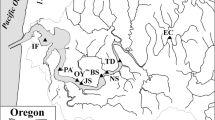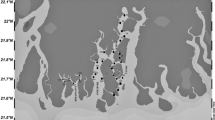Abstract
The distribution of nitrification potential (NP) with depth in sediment and season was investigated in a shallow sandy sediment (0.5 m water) and a deeper muddy sediment (17m water). In both sediments, nitrifying bacteria were present in the anoxic strata (oxygen penetration was 5 mm below the surface). The NP at 6–8 cm depth in the sediment was 50% and 10% of the surface NP at the sandy and muddy sediment, respectively. It is suggested that bioturbation and physical disturbance of the sediment were the most likely reasons for this distribution. The NP increased as sediment temperature decreased. This effect was less marked in the muddy sediment. It is concluded that during the summer, the numbers or specific activity of nitrifying bacteria diminished for the following reasons: There was decreased O2 penetration into the sediment and increased competition for O2 by heterotrophs; there was increased competition for NH4 + and there was inhibition by H2S. These effects counteracted the potentially higher growth rates and increased rates of NH4 + production at the elevated summer temperatures. The potential nitrification rates in the upper 1 cm, which were measured at 22°C, were converted to calculated rates at the in situ temperature (Q10=2.5) and in situ oxygen penetration. These calculated rates were shown to closely resemble the measured in situ rates of nitrification. The relationship between the in situ rates of nitrification and the nitrification potential is discussed.
Similar content being viewed by others
References
Armstrong, F. A. J., C. R. Stems, and J. D. H. Strickland: The measurement of upwelling and subsequent biological processes by means of the Technicon Auto-analyzer and associated equipment. Deep-Sea Res.14, 381–389 (1967)
Belser, W. L.: Population ecology of nitrifying bacteria. Annu. Rev. Microbiol.33, 309–333 (1979)
Blackburn, T. H.: Seasonal variation in the rate of organic N mineralization in anoxic marine sediments. Colloque Internationale C. N. R. S. Biogeochemie de la Matiere Organique a l'Interface Eau-Sediment Marin. Edition du centre national de la recherche Scientifique, pp. 148–153 (1980)
Blackburn, T. H., and K. Henriksen: Regenering af naeringssalte fra sedimenter. Vand10, 117–122 (1979).
Bremner, J. M. and L. G. Bundy: Inhibition of nitrification in soils by volatile sulfur compounds. Soil Biol. Biochem.6, 161–165 (1974)
Fenchel, T.: The ecology of marine microbenthos. 4. Structure and function of the benthic ecosystem, its chemical and physical factors and the microfauna communities with special reference to the ciliated protozoa. Ophelia6, 1–182 (1969)
Fenchel, T., and T. H. Blackburn: Bacteria and Mineral Cycling. Academic Press, London (1979)
Henriksen, K.: Measurement of in situ rates of nitrification in sediment. Microb. Ecol.6, 329–337 (1980)
Kanneworf, E., and W. Nicolaisen: The “Haps”, a frame supported bottom corer. Ophelia10, 119–128 (1973)
Knowles, G., A. L. Downing, and M. J. Barrett: Determination of kinetic constants for nitrifying bacteria in mixed culture, with the aid of an electronic computer. J. Gen. Microbiol.38, 263–278 (1965)
Muus, B. J.: The infauna of Danish estauries and lagoons. Medd. Danm. Fisk.-og Havunders. N. S.5, 1–316 (1967)
Nixon, S. W., C. A. Oviatt, and S. S. Hale: Nitrogen regeneration and the metabolism of coastal marine bottom communities. In J. M. Anderson, A. MacFadyen (eds.): The Role of Terrestrial and Aquatic Organisms in Decomposition Processes. Blackwell Scientific Publications, Oxford (1976)
Painter, H. A.: A review of literature on inorganic nitrogen metabolism in microorganisms. Water Res.4, 393–450 (1970)
Revsbech, N. P., J. Sorensen, T. H. Blackburn, and J. P. Lomholt: Oxygen distribution in sediments measured with microelectrodes. Limnol. Oceanogr.25, 403–411 (1980)
Revsbech, N. P., B. B. Jørgensaen, and T. H. Blackburn: Oxygen in the seabottom measured with a microelectrode. Science (1980)
Solórzano, L.: Determination of ammonia in natural waters by the phenolhypochlorite method. Limnol. Oceanogr.14, 799–801 (1969)
Sørensen, J., B. B. Jørgensen, and N. P. Revsbech: A comparison of oxygen, nitrate, and sulfate respiration in coastal marine sediments. Microb. Ecol.5, 105–115 (1979)
Author information
Authors and Affiliations
Rights and permissions
About this article
Cite this article
Hansen, J.I., Henriksen, K. & Blackburn, T.H. Seasonal distribution of nitrifying bacteria and rates of nitrification in coastal marine sediments. Microb Ecol 7, 297–304 (1981). https://doi.org/10.1007/BF02341424
Issue Date:
DOI: https://doi.org/10.1007/BF02341424




